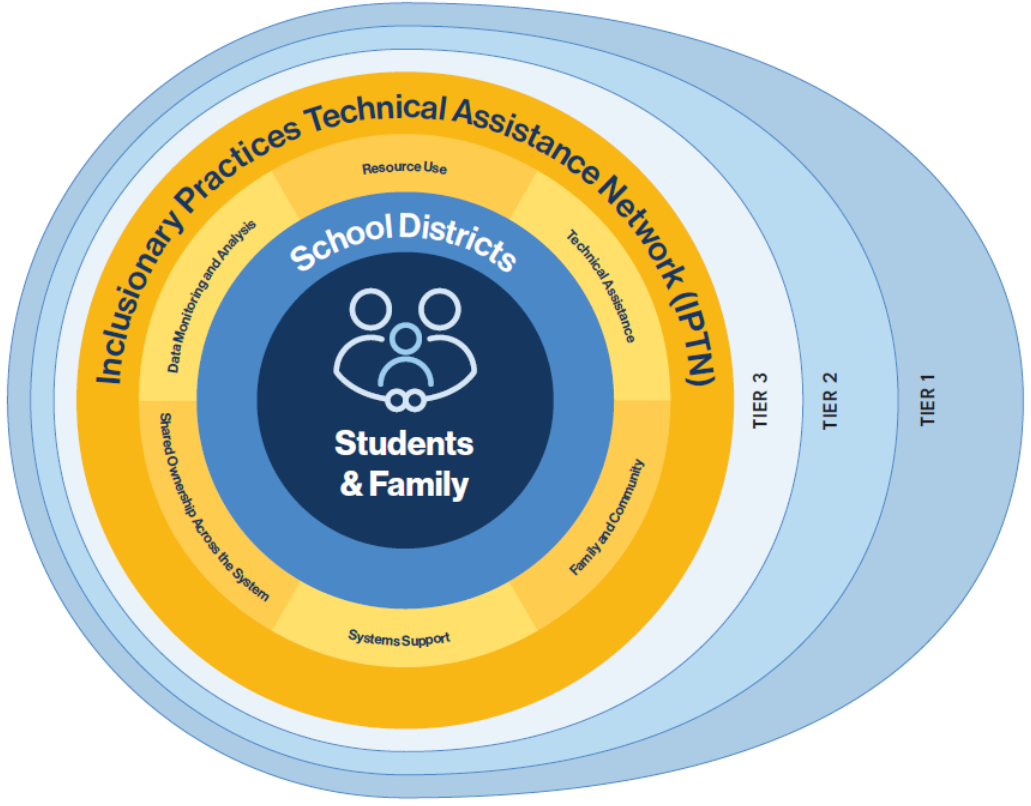How the IPTN Works
Contact Us
We are eager to hear from Washington families, students, educators, and other community members about ways the IPTN could better impact the network’s aim.
If you want to learn more about the work of the IPTN, including ways to talk to someone on the IPTN leadership team, email IPTN.
The IPTN functions by assembling leaders from technical assistance (TA) organizations into a collaborative network. This network is structured into various communities of practice, each focusing on different drivers of significance related to the aim of the network. Network drivers encompass the following areas:
- Data Monitoring and Analysis
- Strategic Resource Use
- TA: Evidence-Based Practices & Adaptive Leadership
- Shared Ownership: “De-siloing”
- Family and Community Partnerships
- Educator Recruitment and Retention
Within these communities, TA providers engage in vital activities that include identifying and addressing crucial needs for creating inclusive educational systems. They work collaboratively across different levels of influence to implement systemic improvements in Washington’s school systems. In addition, they receive personalized support from the staff of OSPI and other partners, ensuring that their efforts are aligned with the broader network.
IPTN Theory of Action
The theory of action below defines the concrete actions IPTN members take in order to impact the network’s aim. Much of this work involves an ever-evolving progress where members reflect on the overall vision of the network and identify clear actions that have the potential to positively impact this vision.
Action we will do as members of the IPTN
- Understand the core components of the aim statement and focus on student populations,
- Become fluent in navigating and communicating about Washington’s inclusion rates for all students, including Black students with disabilities and students with intellectual and developmental disabilities,
- Learn from the IPTN Advisory to better understand the lived experiences of individuals and communities impacted by exclusionary practices and learn concrete ways to make Washington schools and school systems more inclusive,
- Create our own organizational theory of action for our organizations defining clear, specific, and measurable actions we are taking, the outputs we expect those actions to produce, and the ultimate outcomes our actions are working toward related to more effective inclusionary practices for Black students with disabilities and students with intellectual and developmental disabilities,
- Give, gather, and apply key learnings, technical assistance topics, and collective network actions from IPTN sessions to both work within our organizations and activities pursued in IPTN communities of practice,
- Collectively contribute to tools and resources defined within the driver-driven communities of practice that are applicable and scalable at regional, district, and school levels.
- Monitor and share progress, communicate wins, and navigate problems of practice in one-on-one meetings with IPTN design team members and with other network members regarding progress in our network’s theory of action.
- Listen and apply intentional strategies to support IPTN District partners in their work to reimagine systems to be more inclusive of Black students with disabilities and students with intellectual or developmental disabilities.
Outputs we expect to happen from our actions
- Technical assistance organizations across Washington mobilized for collective impact offering products and services focused on increasing meaningful inclusion of Black students with disabilities and students with intellectual and developmental disabilities,
- Co-created artifacts made by IPTN members working together to address unmet technical assistance needs tied to reimagining school systems around the IPTN aim,
- Schools and districts applying key learnings and resources created or curated through the IPTN to address injustices and exclusionary practices within Washington’s school systems,
- Mobilized community partners, including students and families, engaged in sharing their experiences and co-creating solutions to improve inclusion rates in Washington,
- A cohort of local education agencies serving as early adopters, lead learners, and demonstration districts contributing to and testing IPTN-created guidance, products, and resources,
Outcomes we will achieve as a network
Within 1 year,
- LRE 1 for all moving to 2% per year
- LRE 1 for Black students with an IEP moving to 4% per year - Closing Gap
- LRE 1 for students having IDD moving to 6% per year - Closing Gap.
Working Within the IPTN’s Tiers of Support
Within each TA tier, IPTN members are provided the tools and community for making an impact toward the network’s aim. Furthermore, it is through these tiers that IPTN members communicate with the OSPI and with each other regarding how to make a collective impact.
Tier 1 Universal Activities
Collective activities for ALL IPTN members organized around improving access to rigorous standards-based instruction and improved postsecondary outcomes for students with Intellectual and Developmental Disabilities and Black students with an IEP. Examples of these activities include microlearning, cross-organization problem-solving, data-based root cause analysis, community of practice (CoP) share-outs, and informal meetings between members outside of IPTN sessions.
Tier 2 Communities of Practice
Targeted CoPs organized around five systemic drivers that would impact the IPTN aim statement. CoPs are composed of IPTN members based on the sphere of influence these members hold within their roles or based on the mission of their organizations. CoP drivers are centered around the following areas—data monitoring and analysis, strategic resource use, evidenced-based practices and adaptive leadership, shared ownership (“de-siloing”), and family and community partnerships.
Tier 3 One-On-Ones
One-on-one activities between IPTN leadership and IPTN members focused on identifying and carrying out change ideas within their organization’s spheres of influence related to improving the IPTN aim.

The IPTN works within a tiered model of support to create a continuum of training options, community idea-sharing methods, and a collective approach to influencing our network’s aim. This tiered support model differs from that of larger MTSS initiatives happening in the state for schools and districts, though many members of the IPTN have spheres of influence that intersect with these efforts.






